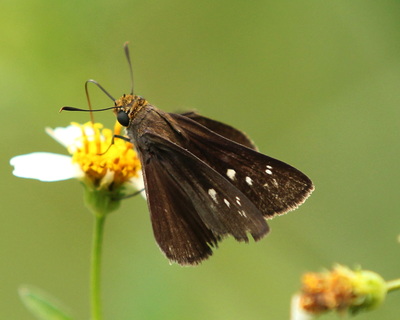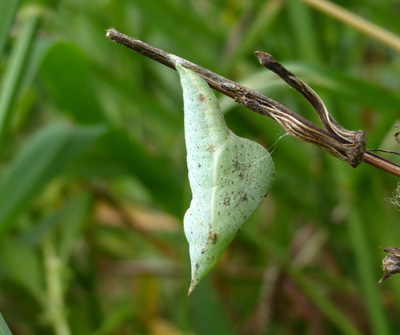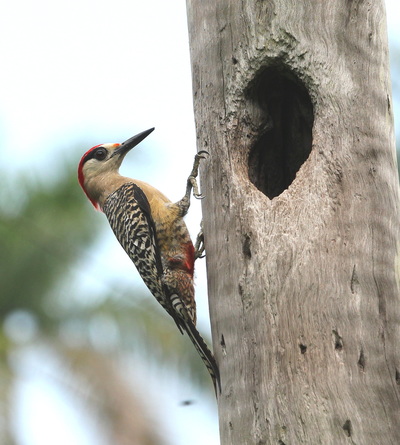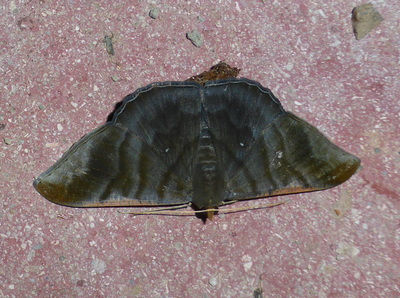|
Today we again went to the top of the hill and walked down a short way before a shower sent us back to the vehicle for shelter. Somebody had left a cut guava beside the road and on it was feeding a Dusky Emperor. We had seen these on three previous days of our holiday though they were never fresh and never close so it was nice to be able to get prolonged views of this one as it fed at close range. We decided to explore the edges of the hotel garden and Rayner quickly spotted a Perching Saliana Saliana esperi settled on broad-leaved low vegetation as they often do. They can also settle on the underside of leaves as several of the skippers do. This butterfly is found in Central and South America but in the Caribbean it is found only on Cuba, where it was discovered as recently as September 1991, and Trinidad which is only a stone’s throw from Venezuela. It has been given subspecies status Saliana e. soroa. The foodplant is unknown in Cuba and the larvae have never been found on the island till now but… see the next blog! Rayner also managed to see Perichares philetes Caribbean Ruby-eye here too but although I was only yards away each time I missed it on both occasions and it didn’t reappear. They are found only in the deepest shade and often very close to streams. This was a lesson to me as I had never thought of looking in such deep shade for butterflies before. Next to the hotel was a small weedy field with sugar cane growing in part of it, and quite a few wild flowers. It looked promising and on entering we immediately saw Antillea pelops Antillean Crescent. This was a good start and the only one we saw during the whole holiday. Then we found both Caribbean Sailor Dynamine serina and Mexican Sailor Dynamine postverta with males and females of each. They were taking moisture from the stems of the sugar cane and sunning themselves on the leaves. We also later in the day watched Siderone galanthis Red-striped Leafwing do the same thing. We found a Sleepy Orange Abaeis nicippe pupa in the grass and there were also several skipper species nectaring on the flowers here including two or three Euphyes cornelius Cornelius Skipper. They weren’t in the best condition unfortunately but still nice to see as we had only seen one once before some 15 months previously. They breed on sugar cane and I suspect this field was never sprayed so presumably they were breeding here. Bauhinia is a flowering shrub/tree with several species in Cuba belonging to the family Fabaceae. They are a good nectar source for several species and a larval foodplant for two skippers Emerald Aguna Aguna claxon and Gold-spotted Aguna Aguna asander. Whenever we saw Bauhinia we made a point of searching for feeding damage and larvae. There were some Bauhinia bushes on the edge of hotel garden which were buzzing with activity with Oviedo’s Swallowtail Heraclides oviedo, Polydamas Swallowtail Battus polydamas, Statira Sulphur Phoebis statira and Cloudless Sulphur Phoebis sennae and a search here provided one Aguna egg and quite a bit of feeding damage but despite much searching, no larvae. Rayner wasn’t sure to which of the two species the egg belonged. It was also interesting to see how variable the male Cloudless Sulphur Phoebis sennae were. I have mentioned before that here at Soroa there are 25 species of lizard including a remarkable 11 anole species. Whilst photographing a West Indian Woodpecker that was nesting in a hole drilled in a telegraph pole I noticed a movement at my feet. It was a female Cuban Green Anole Anolis porcatus being chased by a male who eventually grabbed her by the head before mating with her. At the top of the hill above the Orchidarium is the Castillo en Las Nubes that was severely damaged by the hurricane in 2009. When we saw it last in February 2014 it was derelict and we said then that it would be great if it was done up because of the fabulous location. It is owned by the government and is part of the hotel group in which Hotel Villa Soroa is run. While we were there on this occasion it was being renovated to a high standard and wasn’t far off being finished. The floor layer was working at nights to lay the internal and external tiles as it was cooler than doing it during the day. The security guard told us that in the mornings there were hundreds of moths attracted to the light that was being used and suggested that if we came up late one evening we could see them, so we did! We stayed for about an hour and there were lots of moths as well as other fascinating insects coming to the twin fluorescent light that they had hung temporarily on the outside for us. And four species of longhorn beetle were attracted to the light. Another amazing day with lots of great wildlife sightings and a total of 53 butterfly species seen today – one up on yesterday!
0 Comments
Leave a Reply. |
Welcome to our Blog
Here we will post interesting news about what we and others have seen in Cuba. Archives
July 2024
Categories |













































 RSS Feed
RSS Feed